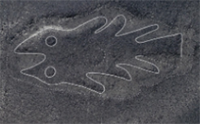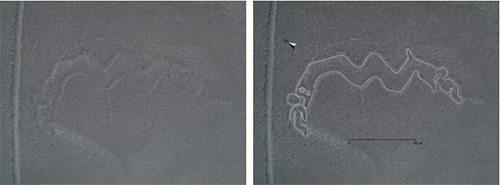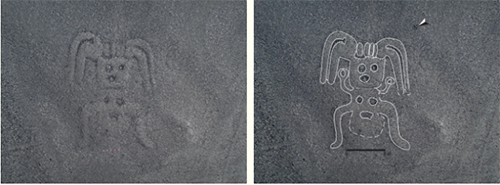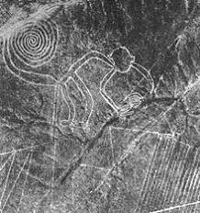|
AI Helps Find 140 New Nazca Lines
November 18, 2019
The geoglyphs are in the same area as the Nazca Lines, a large number of geometric and animal-like shapes about 250 miles south of Lima that can be discerned only from high up. The new figures ranged in length from 15 feet to 500 feet. Among the new shapes discovered, in part by using artificial intelligence, was a humanoid figure that looks like it is holding what might be a club. Human figures feature in another newly discovered figure, one that appears to be a two-headed snake that is about to consume what look to be human figures. Masato Sakai, a cultural anthropologist at Japan's Yamagata University, was the leader of the team of researchers. They have spent several years searching the sands of the Peruvian desert, both on foot and in planes. The researchers labeled the larger glyphs Type A and said that they were generally animal-like in shape and dated to the later Nazca civilization. By contrast, the Type B glyphs are smaller and date to the earlier Nazca culture. Helping discover one of those Type B figures was the IBM Watson Machine Learning Community Edition. It was the first time that artificial intelligence had suggested a possible site for a glyph; the researchers said that they would use the technology again. The Nazca culture flourished in Peru from about A.D. 200 to about A.D. 700. Several times throughout their history, the Nazca people dragged a series of great rocks through the desert with deliberate attempt, creating shapes that look like a monkey and a hummingbird and several kinds of geometric shapes and at least one set of human-like figures. The largest figures are 1,200 feet long. Experts have studied the Lines off and on for the hundred years or so since they were discovered. So far, the scientists have identified hundreds of simple lines and geometric shapes, a large handful of tree- and flower-like shapes, and more than 700 animal-like shapes. Among the animal-like shapes found are birds, fish, jaguars, monkeys, and llamas. One of the most famous of the shapes depicts a spider. The Nazca people created their figures by digging a shallow trench of between 4 and 6 inches deep, removing the reddish-brown pebbles that form much of the Nazca Desert's surface material to reveal the light-colored clay underneath. The desert is one of the driest and least windy on Earth; that combination has helped to preserve the line patterns long after the Nazca culture was succeeded by others. The Nazca Lines have been a UNESCO World Heritage Site since 1994. The latest discoveries followed one just last year, in which scientists employing low-flying drones discovered 50 barely visible lines to add to the Nazca collection. |
|
Social Studies for Kids
copyright 2002–2024
David White



 Researchers have uncovered more than 140 new sand "pictures" in Nazca, Peru. Some of the figures appear to be humanoid.
Researchers have uncovered more than 140 new sand "pictures" in Nazca, Peru. Some of the figures appear to be humanoid.



